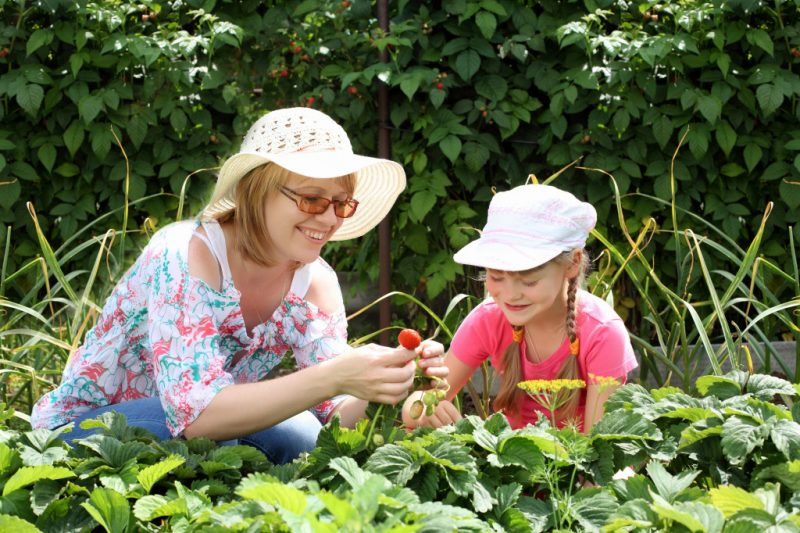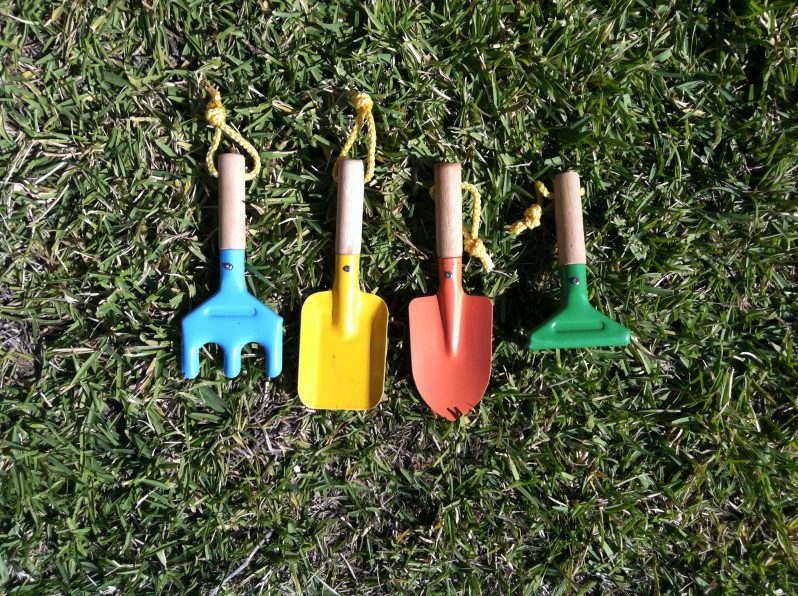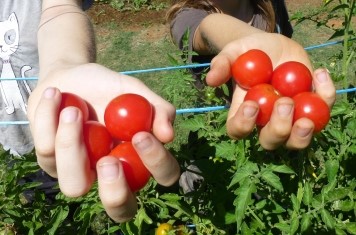Teaching goes beyond classrooms and playgrounds – they work fantastic in the garden as well. There’s a lot kids can learn being in the vast outdoors than they do from books. Introducing them to gardening is a great way to spend quality time while honing skills, like responsibility, self-confidence, reasoning, and respecting nature in all its glory.
Kids are going to be kids, and it’s a given that they absolutely find great joy in getting down and dirty, be it in the playground or in your backyard. But that’s great, because getting their hands dirty while gardening can actually strengthen their immunity and overall health. What’s more? They are getting a good share of physical activity and sunshine while keeping the garden in great shape.
Gardening is a creative way of making your child think out-of-the-box and have loads of fun in the process. In fact, a study showed that children who participated in gardening projects scored higher in science than other subjects. Activities, like digging, carrying a watering can, moving soil, pushing a wheelbarrow promote motor skills and build strength for a more fit body.
Gardening activities to engage your kids
You don’t want young, budding landscape perfectionists to feel left out; give them robust garden tools and their very own space to watch their garden grow. Here’s what you can do to boost their interest and channel their energy in the right place:
Ownership of their garden beds
Give your kids their very own raised bed, container, ground plot right in the middle with the best soil and sunlight.
Refurbished sandbox
If you think your kids have outgrown their sandbox years, it’s time to turn the sandbox into a garden bed of sorts. It’s a great way to encourage a sense of responsibility and continued ownership of familiar territory.
Hard core gardening tools
Plastic gardening tools is an absolute put-off for anybody, and it works just the same for kids. Besides being fragile, plastic tools can be frustrating to work with. Take some time to locate good-quality gardening tools for tiny hands – gloves, spade, hoe, shovel, rake, and trowel.
Planting seeds
Begin with the basics – start from the seeds. It’s a great way for kids to observe, learn, and understand the growing process. Nurturing seeds is a crucial part of gardening, and they usually start in the warm indoors. Once they sprout, transfer them into a container, or place them into mini-greenhouses directly on a garden bed.
Kid-friendly gardening tools
Gardening is not going to entice your kids unless you pack a punch with the right gardening tools. It’s the ideal reason for them to get down and dirty, and it’s all for the greater good. Depending on your location, budget, and preferences, garden tools are available online on Babble, The Home Depot, Tesco, and others.
Rake
- Helps break soil clumps, gets rid of stones, and debris
- Used to spread mulch
- Weeding
- Used to spread ground covering, like tree bark and chips
- Moving, leveling, and grading across a surface
Trowel
- Used to move plants from one location to another
- Hold compost for planting flowers or potting
- Clearing a hole for a new plant
- Weeds without disturbing nearby plants
Hoe
A versatile tool used to shape or pile soil around the plant base, and digging furrows to plant seeds or bulbs. Hoes can also be used for weeding or cutting foliage from roots and getting rid of old roots.
Shovel
This tool has a broad blade fixed to a medium-length handle, and are used for digging, lifting, or moving materials – gravel, soil, sand, or snow.
Garden gloves
Making sure your kids are wearing the right size gardening gloves to keep their tiny hands and fingers safe. They protect your nails from getting dirty, and your hands from pricks and cuts. Your kids will be safe from soil contaminants as well.
Garden gloves are available in eye-catchy designs and colors, so you won’t have trouble getting your kids to slip them on before they take to the soil.
Watering can
This is an absolute must! Kids are going to love it, and they aren’t anywhere close to the boring watering cans adults use. You’ll find a ton of bright and colorful watering cans in different shapes and designs online.
Get one that your kids fancy, something on the lines of their favorite superhero or animal, or just about anything that matches up to their imagination.
Wheelbarrow
This is a great way to develop motor skills while transporting soil, mulch, plants, and gardening tools. You’ll find them in just the right size and weight to fit your child’s hands and they aren’t heavy. They might look like wheelbarrows for adults, but in truth, they are made with your kids in mind.
Garden markers
They are a great way to teach your kids about gardening while getting them to tap their creative bend of mind. Like the term denotes, garden markers are used to mark your plants with their names and species.
Markers are available in all kinds and shapes for kids – you could turn a Popsicle stick into a garden marker, or even a plastic spoon. This is a DIY for kids, and something that would sit just right with them. Encourage your kids to come up with their own ideas rather than having to go with the usual suspects.
Other ideas for garden markers:
- Garden rocks
- Wood burned
- Picket fence markers
- Painted and laminated markers
- Terra-cotta cup markers
8 Amazing Plants for Kids to Grow
Sunflower
Your kids will take to it like a duck to water! They are an absolute favorite with kids because they stand tall and beautiful. Make sure your plant just one or two because sunflowers take up a lot of room. They sprout in 1 week, and become about 2 inches tall in just about a month. It takes about eight weeks, the buds will flower giving way to seed kernels. Should you grow confectionary sunflowers, you can roast the protein and iron-rich seeds as a snack.
Nasturtiums
Young gardeners in the making will like these simple-to-grow flowers which yield instant results. They grow well in sunny, dry areas, and do well in poor soils too. They bloom in 50 days once you plant the seeds, and are pest-resistant which makes them an ideal choice.
Nasturtiums are available in red, orange, and yellow and are an excellent choice for color and texture to your serving of fresh, green salad.
Cherry Tomatoes
They are fun to grow in the garden, and your kids are going to love them! Plant them in full sunlight, and rather than planting from seed, use seedlings instead. Make sure you place a loosely tied 2-inch stake alongside the seedlings. Water them at ground level, and add plenty of compost. Normal growing season lasts about 50-75 days. Guess what? You could grow cherry tomatoes in containers too.
Potatoes
Kids can’t go wrong with potatoes; it’s a never-fail crop. There are the white and red varieties, though the red variety seems to be a favorite with them. Cut the seed potatoes with at least 2 eyes each. Plant them 12-15 inches apart in furrows with the “eyes” faced upward. Make sure you mound the soil around as they grow; when the plant collapses, it’s time to harvest.
Pumpkin
Get your kids to grow pumpkins; they’re easy-going and worth the time and effort. Plant seeds in a small hill – poke 2-3 holes, and place one seed in each hole; they’ll sprout in one week. You’ll notice vine leaves starting to creep on the ground.
They usually take about 120 days to mature. When you notice 3 pumpkins on the vine, get rid of any new blossoms. They are ready when it feels hard on the outside and hollow on the inside.
Carrot
Plants the seeds directly into the soil (carrots grow well in cool temperatures). Make sure the soil is clear of rocks and debris to allow room for the plant to grow. Carrots take their own sweet time to germinate, so patience is something kids will learn. Water the plants well and thin them to about 3 inches since crowding the area will produce foliage but no roots. Carrots take about 60 days to reach maturity.
Radish
Kids don’t fare too well playing the patience game, so this one is for them – quick results. Radishes germinate in 3-10 days, and take about 20-30 days to grow to maturity. Plant them in cool or hot weather depending on the variety. Take care to plant radishes 4-6 inches apart and not too far off.
Snow Peas
These fast-growing dwarf plants are quite the favorite with young gardeners – they get to eat right off the vine! Peas are fond of part shade, cooler locations in the garden. They take about 10 days to germinate and usually mature in about 60 days. Plant them about an inch apart, not more.
Other fun ideas for kids
Egg carton planters
Who would have thought those egg cartons would come in handy! Sure enough, kids can grow a thing or two in these cartons. All they have to do is fill the hollow cups with potting soil and put in the seeds – cotton seeds are a great start.
Keep the dirt moist, and once kids are done sowing the seeds, get them to cover the egg cartons with a plastic bag to retain the moisture and create the ideal greenhouse effect. But before they do that, get your little ones to name each cup with the seed they planted.
That’s it, you’re all done! Place the egg cartons on the window sill for some sun, and they’ll grow nice and easy. Just check on them once in a while to see how they’re doing.
Quick planters for your 2-year-old
Patience is the last thing you can hope for with kids as young as this; you have to keep them engaged with fast-moving plants. Peas or beans work just great. Place the seeds and mildly moistened cotton balls in a transparent plastic cup or Ziploc bags. You could place them by the window where there’s enough sunlight. Once you notice the sprouts, transfer the seedlings to a garden or a container.
Building a tepee for the adventurous mind
If your kid is 3-4 years old, they’ll love the bean tepee. It’s easy, fast-growing, and just ideal as a makeshift fort. Make sure the spot gets at least 6 hours of sunlight every day. Get about 4-5 six-feet wooden stakes or you could even use fallen tree branches robust enough to support the growing vines. Plant them a few inches into the ground and tie the stakes at the top to mimic a tepee.
Add some new soil around each stake and have your kids press down a few bean seeds about an inch into the soil. In a few weeks, you’ll find sprouts find their way up the stakes! Lo and behold! Your kid’s very own tepee is all set for occupation.
Peak your kid’s interest with gardening
Kids by nature are curious cats, and getting them to tend to their very own garden comes with its perks. They get to watch, learn, and reap the spoils of their very own handy work. It’s a great excuse for them to dirty they hands and feet and turn into responsible and confident budding gardeners. What’s more? It’s a great way for kids to understand environmental awareness while furthering their motor skills.
If your kids are fussy eaters, having them to work their very own garden is a smart way to get them to love their veggies. It’s true! A study shows that children who grow up around homegrown vegetables are more likely to love their veggies and fruits.
Gardening is another excuse for them to get out and bask in the sun and soak in their share of vitamin D and get those tiny hands and feet moving. It’s a foolproof way to tap into their creativity and get them interested in nature with all its bounty.
It’s great that you’re prodding your kids to get sun, wind, and water, but you can’t overlook dressing your kids in the right attire for gardening. Too much of sun can be harmful for your little ones, so make sure they have the right gardening clothes on – hat, gloves, apron, boots, and of the sorts.
Rather than having your kids falling prey to video games and TV, gardening is loaded with fun activities to keep your kids glued. It’s simple, easy-to-do, and they’ll reap the benefits too.














No Comments